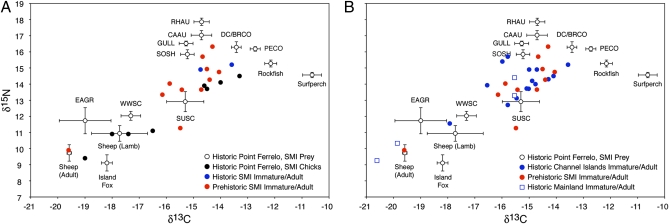Fig. 3.
Bivariate plot of mean δ13C for δ15N values for bald eagles and the most abundant prey items found in the Ferrelo Point nest on SMI. (A) Bald eagle specimens collected on SMI from historic and prehistoric contexts. (B) Historic and prehistoric bald eagle specimens collected from throughout the CI and adjacent mainland. Error bars represent SE. Table S1 presents sample sizes of potential prey. CAAU, Cassin's auklet; DC/BRCO, double-crested or Brandt's cormorant; EAGR, eared grebe; GULL, large gulls (Larus spp.); PECO, pelagic cormorant; RHAU, rhinoceros auklet; SOSH, sooty shearwater (Puffinus griseus); SUSC, surf scoter (Melanitta perspicillata); WWSC, white-winged scoter (Melanitta fusca). Sheep were grouped into separate age classes (lambs and adults) because of significant differences in mean δ13C values (t test, P < 0.05). Bald eagle bone collagen isotope values were corrected for trophic discrimination by subtracting 1.5‰ and 3.0‰, respectively, from measured δ13C for δ15N values. Bald eagle feather isotope values were corrected for tissue-specific and trophic discrimination by adding 1.5‰ and subtracting 3.0‰ from measured δ13C for δ15N values. Further clarification on discrimination factors is given in Materials and Methods and SI Text. Table S3 gives the collection location, collection year, and age of each bald eagle specimen.

